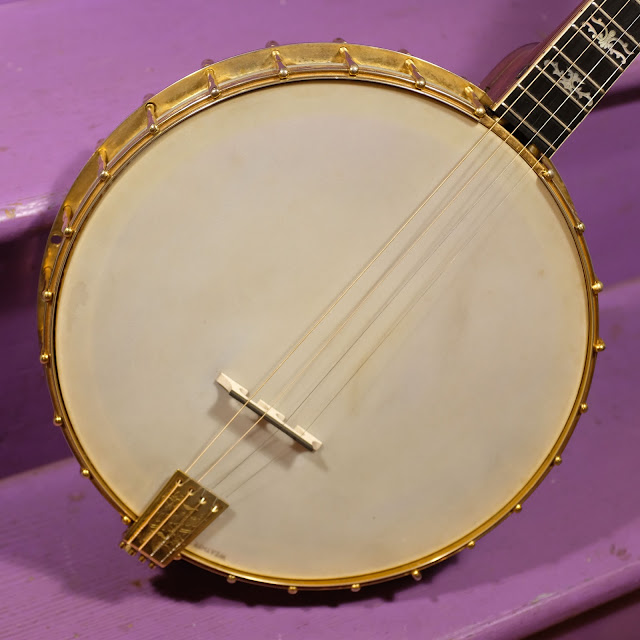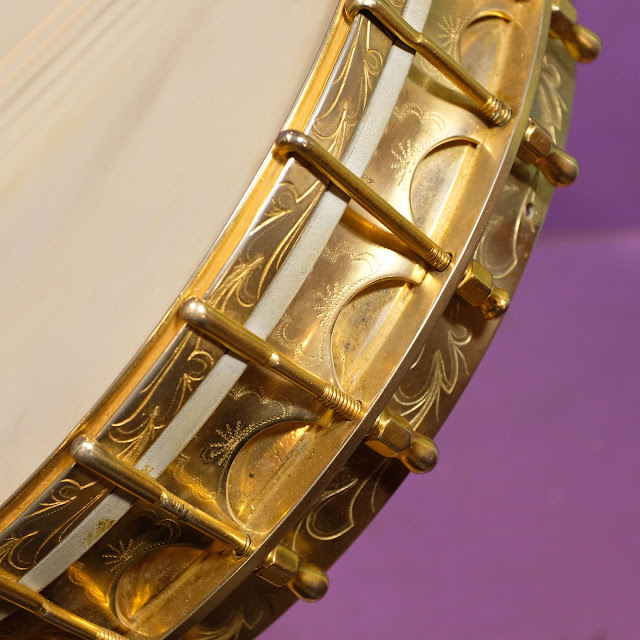1920s Ludwig Ambassador Tenor Banjo
This beautiful old banjo is a little bit of a hard-luck case, but it's shining now. Its rim is two-piece, gold-plated brass and engraved like mad all over it. The neck is thin and fast but dead straight and has engraved pearl up and down. This was clearly aimed at the professional market when it was made and it would've had a resonator when it left the factory -- which meant that the already-loud/cutting voice would've been even louder and more direct.
The trouble with this banjo is that it had a twice-repaired (hah, hah) series of heel cracks when it came in and the neck was broken at the heel when it came in and missing a heel cap. Otherwise, it was in pretty good shape aside from a thick coat of extra finish on the headstock and one light coat of overspray on the rest of the neck.
The trouble with this banjo is that it had a twice-repaired (hah, hah) series of heel cracks when it came in and the neck was broken at the heel when it came in and missing a heel cap. Otherwise, it was in pretty good shape aside from a thick coat of extra finish on the headstock and one light coat of overspray on the rest of the neck.
Work included: heel repair with 4 screws, glue, and a new ebony heel cap, a fret level/dress, general cleaning, and a good setup. It has a straight neck, plays with spot-on 1/16" action at the 12th fret, has good fret life left, and is strung with 32w, 20w, 13, 9 strings for CGDA tuning. This is a long-scale instrument so it's more suited to trad jazz or chord-melody players than "Celtic" or single-note players who might prefer short scale.
Scale length: 22 7/8"
Nut width: 1 1/8"
String spacing at nut: 13/16"
String spacing at bridge: 1 3/8"
Nut width: 1 1/8"
String spacing at nut: 13/16"
String spacing at bridge: 1 3/8"
Head diameter: 10 7/8" with older Remo frosted-top head
Side depth: 2 5/8"
Rim: two-piece brass with integral tonering
Neck wood: two-piece mahogany with center strips
Fretboard: ebony
Neck wood: two-piece mahogany with center strips
Fretboard: ebony
Neck shape: flat board with thin, fast, C-shaped rear
Bridge: maple/ebony 5/8"
Nut: original bone
Tonering type: integral/arched metal
Condition notes: neck has one shot of overspray with a thicker, 2-3 coats at the headstock. It's missing its original resonator and the brackets for the armrest (but the armrest is in the case), but otherwise it's all-original save the head and bridge. Of course, it also has wonk at the heel where it's now been repaired for the third time.
It comes with: an older, nice, dust-cover-equipped hard case.
The celluloid binding at the sides of the fretboard have hairline cracks at each fret (from swell/contraction during the year) but is holding fast.
Look closely at the top of the heel at the end of the fretboard -- there are two little cylinders that press-out from the neck's heel into the tension hoop. This is Ludwig's neck-adjustment gizmo! Between the two of them you can set back-angle and right/left direction on the fly. This is a very helpful setup feature.
The Ludwig-branded tailpiece adjusts for downpressure. Note the '50s-style Remo head logo.
The headstock boasts planetary, 4:1 geared pegs with actual pearl buttons.
The mahogany neck has some nice flamey figure to it.
Here's the bad part -- the heel! When I first put this back together, I just glued-up the heel, installed a new ebony heel cap, and crossed my fingers. Of course, once I applied tension to the neck brace, it shot apart on the original "repaired" break. I decided to go the ugly route and installed 4 screws buried in the heel (plus glue) to solve the problem for good. The pearl dots cover the entry route and also provide access to the screws in case it ever needs to be taken-apart again.
The little screw/bolt in the top side of the heel is what adjusts the cylinder-posts that set neck angle. Neat, huh?
Here's my favorite part -- just look at that rim! It's a couple pieces of brass put together with the "tonering" side of it the bit with the arches coming down at each hook and suspended on top of the "donut"-arched bottom rim and flange.
Curiously, the dowel-stick just sits in the rim at the tailpiece-side. It's not even bolted in place.
The neck brace is a very-smart leveraged unit that adjusts with the bolt above it.
The tailpiece adjusts for downpressure and side-to-side angle.
Here's the '50s/'60s-era hard case with its dust-cover interior. The original armrest is in the case and it's engraved, too.






















Comments
Steve Colby
480-600-5392
Sun Lakes, AZ
DJ Whitehair
djwhitehair@gmail.com